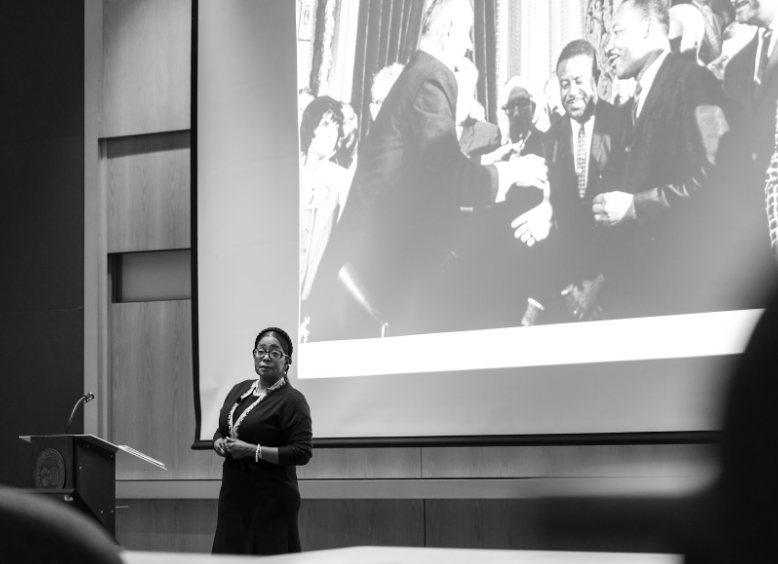On a large projector screen in Donahue Auditorium, the black and white image of Martin Luther King Jr. looked down at an audience of current John Carroll students, prospective students and life-long friends of the civil rights icon. Pictured next to King was Reverend Ralph Abernathy, King’s longtime partner and the man behind much of his success.
When King was reluctant to get involved in the Montgomery Bus Boycott, it was Abernathy who pushed him to do so. When President Lyndon B. Johnson signed the Civil Rights Act of 1964 into law, Abernathy stood next to King to witness it. When King was assassinated, it was Abernathy who gave him the last rites.
In front of the projector screen, Abernathy’s daughter, Donzaliegh Abernathy, stood dressed in black. It was a fitting wardrobe choice. She was speaking just one day before the anniversary of the death of the man she called “Uncle Martin.” Since that fateful day, the younger Abernathy has worked as a civil rights activist and Emmy award-winning actress. Abernathy was invited to speak at John Carroll University as the keynote speaker for the Mosaic Program on April 3, 2025.
The speech opened with two introductions. The first came from John Paul Robinson, the director of DEIB at JCU. Robinson said he works to “expose our campus community to lots of different voices… That’s important to us.” Robinson then introduced Brey’Aisa Worthy ’24, the vice president for Black Students in Action at John Carroll. Worthy delivered a passionate introduction for Abernathy. Worthy emphasized that “her life and work has embodied the spirit of resilience, creativity and social justice.” With a hug, Worthy gave the floor to Mrs. Abernathy.
Abernathy’s speech was a freewheeling hour of personal reflection, historical insights and the occasional moments of levity. She began by reflecting on the date of the speech. Abernathy called it “the first time ever I’ve been invited to be a part of something that will commemorate the loss of Martin Luther King Jr., Uncle Martin.”
Abernathy emphasized the importance of nonviolence in the movement her father helped lead and in which she participated. Abernathy said “When you are non-violent, you will appeal to the subconscious mind of your oppressor.” She revealed that King was not comfortable with non-violent ideals from the beginning. Abernathy said “Uncle Martin had to work at it.” King, however, had a good teacher in Glenn Smiley, a fellow Civil Rights Activist who introduced King to Mahatma Gandhi’s ideals of non-violence.
Next, Abernathy discussed the day when King was shot. Choking up, Abernathy recalled how her father had been interrupted in the middle of applying his cologne by the sound of a gunshot. She told how her father had seen the way the bullet had pierced King’s right cheek, how the staff in the trauma bay had been impolite to the leader, even as he lay dying. She recalled how she was the last person to see his body at the viewing. Abernathy described the assassination as a personal memory rather than a historical event, though she, in time, gave up the event to history. Abernathy said “He now belongs to the ages. Now he belongs to you all.”
While the speech was mostly focused on the past, Abernathy could not help but occasionally express concern for the country’s present and future. Referring to King, she said “What you need to learn from him is how to live… how to stand up for American democracy, because we are at a crossroads as a nation.” Abernathy, in particular, pointed to anti-DEI policies as concerning. At the end of her speech, Abernathy said “I am diversity. I am equity. I am inclusion. And I am proud of it.”
Reflecting on Abernathy’s speech in the current cultural climate, Worthy told The Carroll News, “as a young adult still trying to figure out life for myself in the current cultural climate, Mrs. Abernathy’s visit and Dr. King’s Legacy provided a much-needed sense of hope and inspiration for the future.”
In the 60 years since Martin Luther King Jr. was killed, progress has been made and in the eyes of some, lost. But, with a black and white image from the past behind her, Abernathy reminded the college students in attendance that they are more than the past: more than black and white.


